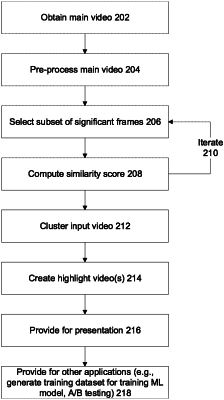| CPC G06V 20/47 (2022.01) [G06V 10/761 (2022.01); G06V 10/762 (2022.01); G06V 10/7747 (2022.01); G06V 20/41 (2022.01); G11B 27/031 (2013.01)] | 22 Claims |

|
1. A computer implemented method of generating at least one highlight video from an input video, comprising, using at least one processor for:
identifying a plurality of significant frames of the input video;
computing video-level features of the input video;
selecting a plurality of subsets of the plurality of significant frames;
for each subset, computing a similarity score indicating similarity between visual features of the subset and video-level features of the input video;
clustering the input video into a plurality of clusters of sequential frames according to sequential positions within the video based on the similarity scores correlated with the plurality of significant frames;
creating at least one highlight video by selecting a cluster of sequential frames of the input video;
computing a normalized score by normalizing the similarity scores of the at least one highlight video, and presenting each of the at least one highlight video a relative number of times corresponding to the normalized similarity score, wherein the at least one highlight video are presented to a plurality of client terminals accessing a web page;
testing the at least one highlight video presented the relative number of times corresponding to the normalized similarity score to obtain a click rate for each of the at least one highlight video;
generating a multi-record training dataset, wherein a record comprises a sample main video, and a ground truth of the at least one highlight video generated from the sample main video each labelled with a corresponding click rate; and
training a machine learning model for generating an outcome of a target highlight video predicted to generate a highest click rate in response to an input of a target main video.
|